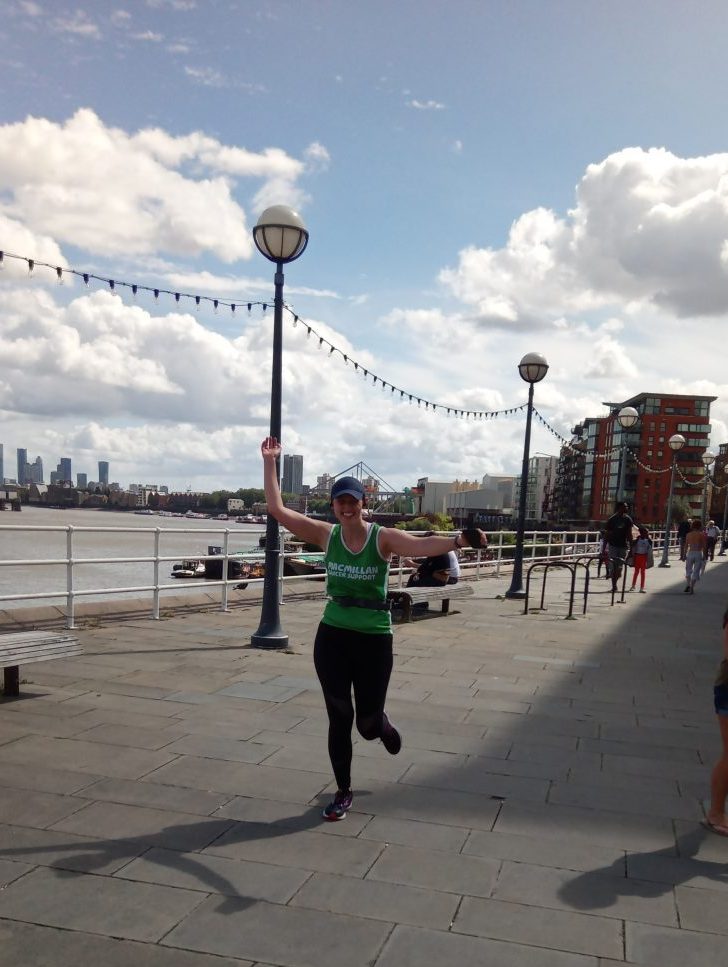Running Every Day

Today is day 16 of attempting to run every day.
I was inspired by the annual RED challenge in the UK, which has been going for a while. It wisely softened its stance from the original premise of “Run Every Day” to simply moving every day, with an emphasis on the mental health benefits it can bring. Though I’m not officially signed up, it’s a nifty thing and you can read more about it here.
I am already lucky enough to usually do some kind of daily movement – whether running, cycling, going for a walk, practicing escrima etc. – but running every day has always evaded me. I tried a few years ago, but fairly quickly experienced pain I felt was going to turn to injury if I kept pushing, so stopped.
Now I’m trying again, with more experience under my belt and a firm understanding that if I do experience discomfort that could be headed for injury, I’m immediately tapping out.
Naturally, before starting the challenge, I googled everything about it I could – and found remarkably little. This, therefore, is my entirely personal, entirely subjective experience of running every day in January, thus far….
About Me
The goalposts for ‘average runner’ seem to get narrower every year, encompassing 20 minute PBs at your local Parkrun and a casual marathon every other week. The images we see are of beautiful, muscular people bounding up mountains in the evening sun, before finishing their day with their equally beautiful friends drinking a home-made fruit smoothie/protein shake on a balmy beach, then doing it all again, better.
I am not that. I am a plodder. A back-of-the-pack slowcoach. In winter my fingers turn blue; in summer I come home with face like a salt and vinegar crisp.
I am a 36 year old woman who, on a tough month (real-life commitments/illness etc.), runs about 40km, and on a good month maxes out around 100 km – so anywhere between 10-25km a week of running, depending on how things are going. I’m chuffed to get a 5km in less than 30 minutes – and my long runs are anywhere from 14-18km depending on whether I’m training for the longest distance I’m prepared to do at this time: a half marathon.
Could I train for a marathon?
Probably?
But I’m unwilling to give up my social life and other hobbies to do so. Running is lovely, but despite this post, it’s not in fact my world.
I run for physical health, sure, but I also run for mental wellbeing.
I say all of this because bizarrely, even while doing something as excellent as going for a run, it’s possible to feel shame. To feel that you’re not good enough, fast enough, strong enough, sleek enough compared to the sexy sleeksters speeding by – even while you’re literally doing the badass act of running. This unhealthy comparison can sour frankly any relationship with anything, and is why I want to be explicit about how I run, and how as well as the miles and minutes, I’m also trying to put the work into being ok with just being me, trotting along at the back, and that being more than enough.
If you have ever run and felt this way, then hello. You are not alone.
Shrinking Distances
So here we are, mid-January, and having said all of that, I’m doing this bonkers thing.
Running every day removes one of the best bits of running – the day off. Muscle only builds when it has time to heal, and I suspect the main reason I wound up nearly injured last time was because I tried to maintain my usual running patterns, including long runs and speed work, rather than acknowledge that chilled was the way to go.
This time my average daily run for the month of January is around 3-4km.
Some days I just about clock a mile (1.6ish km), heading to and from the shops. Others I’ll churn out a 5km loop, but won’t beat myself up if I come in at 4.5km. My longest run thus far has been an 8km run to and from a hardware shop, which actually felt incredibly liberating after all these short stints round a very familiar block.
I am not bothering with anything other than just getting out there, though if my legs wanna go fast on a short run I won’t hold back. I am also throwing in 5-10 minute chunks of strength work every other day or so, which I can just about tolerate despite how boring I find it, with a grudging acknowledgment that this stuff is necessary to protect my limbs. *Grumble grumble, getting older, grumble grumble….*
By day 7, my legs were thoroughly pooped. Day 8 was a slow slog round the block with the first 2km feeling like I was lifting potato-thighs, though I was relieved that my limbs sorted warmed up eventually. On day 9 I was surprised to discover a bit of speed coming back, and as of yesterday’s 7km back from helping demolish a friend’s shed, the legs were… feeling fine? I don’t want to say it with ringing confidence, because the idea seems absurd, but maybe… just maybe… my body is adapting? (While my legs were fine, the curry my friend fed me after demolition, though delicious, was absolutely a run-fuel error. Everyone owes a sacrificial run to the gods of burp every now and then.)
Warm-ups and cool-downs are now much more of a thing than they’ve been before, which if nothing else is a good habit to cement, and even with the reduction in my usual distances, the consistency means that as of today, I’ve run a little over 63km, so am en route for one of my best Januarys ever. On the one hand, I’m delighted by this (and could happily take the next two weeks off); on the other hand, as someone who’d really rather just run 4 times a week and knows how inconvenient all this nonsense is, the fact I’m potentially actually getting better results distance-wise from this behaviour does leave me conflicted, not gonna lie.
Recovery
With the lack of recovery time between even these very short runs, I am (short, post-run) yoga-central.
Bad yoga-central, of course. I personally find yoga pleasant because it’s the opposite of running – it’s lengthening those ligaments, stretching out those joints. But given how tight said ligaments are by this stage, it feels like every week my toes just get further away. I practice at home with an app, to a soundtrack of ‘ugh-agh-bluergh!’ with every move.
I have also experimented with foam rolling. The science is pretty meh as to whether there’s any actual evidence that this works. I guess though, if nothing else, it definitely feels like you’re doing something, (goodness so many sensations) so maybe the placebo effect is as good an analgesic as anything else? Perhaps?
Finally, the day before I started this challenge, I booked myself a massage for the 20th, which I sort of see as a mini mid-challenge reward (I maybe have a massage every three years, despite how amazing it feels), and am looking forward to it more than I’ve ever looked forward to being pummelled in my entire life.
On recovery errors: on the 6th, I gave blood. This was not part of the running plan, but the NHS really, really wanted a pint of the red stuff and I was getting all the emails about the orphans I was personally murdering if I didn’t do my duty, so off I went. This was A Tactical Error. But fundamentally, gotta get your priorities in order. Giving up a bit of time and blood to help save a life: 100% more important than going for a run.
Fuelling
Let’s not shit ourselves, these short runs do not require extra fuelling. But I have been doing a few more unfuelled runs before breakfast than usual, just to get them done, as the rest of the time my runs revolve around the principle that I really do need two hours to digest my oats before major physical activity, and that requires extra planning. (See: curry-disasters.)
I also eat what is sometimes called the climatarian diet – I have a bit of meat and a bit of fish in the week, but generally speaking my shopping basket is veggie. Combined with having spent the last gazillion years on the progesterone-pill in response to polycystic ovaries and a period as stable as current UK politics, sigh, I am a little more aware of keeping an eye on my protein intake than I’ve previously been. I don’t think it’s a biggy – but am aware that most research into nutrition and indeed all medicine ever has been on men, rather than women – and that generally speaking it’s worth having half an eye to making sure things are ok for your actual body and how you actually feel, rather than taking anything for granted.
Bloody January
I get taking on new challenges at the start of the year. It makes total sense. But it’s gotta be said, a running challenge is pretty daft.
It’s daft because in the UK right now, the wind is absolutely, irrefutably in my face no matter which way I turn. My runs are snatched between icy downpours and blustering gales. I think I glimpsed the sun once, but by the time I laced my shoes up to go meet it, it had set again, and has not returned.
I do all the tricks – lay out my running gear the night before, plan everything and put it in my calendar, pair runs with necessary errands to the pharmacist or to pick up bread (but not eggs – my running form is not that smooth) etc.. The bathroom is full of tops I’ve rinsed in the sink, in the hope the icy air and unremitting damp of winter won’t prevent the fabrics from drying before tomorrow’s run. (Sometimes, you just gotta stink.) And on an entirely too-personal note, my skin currently feels like a warzone, as my body tries to work out whether it’s hot enough from exercise to sweat, cold enough from the wind-chill to shiver, or maybe both at the same time. Warm core, numb nose: that’s the theme of this symposium.
Obviously, this is grim. But since I set out to do this challenge more for my mental wellbeing than physical, it’s also kinda the point. Getting out there and finding consistency even when you just wanna be at home is part of the real challenge for me, and often feels like a greater battle than moving those legs.
Conclusion!
This is a stupid challenge.
I mean, no, obviously, it’s not. I’m doing it to try and prove to myself – less physically than mentally – that I am stronger than I think. That I have agency over my body and mind, that there’s some unexpected pools of resilience and I can take control of my time and movement whenever I want. These things should be simple truths, but in this day and age, alas, it doesn’t always feel that way.
There are many extraordinary athletes for whom running every day is just a way of life, who I admire deeply. I’m not one of them. It’s not that my body can’t adapt – I can feel it adapting from a place of already moderately-high-workload, to a little bit more on top of that. But if you’re just starting out in running, then obviously, don’t do this. It’s daft. And if you really, really want to run every day, maybe pick a month when it isn’t pissing it down every time you glance out the window.
I still feel a certain shame about how I run. Whenever I encounter other runners, they all seem to be ripping through times and distances that are inconceivable to me. I tell myself that this is partly because of how I’ve ordered my life – there are, despite appearances, many other things that are more important to me than going faster/longer. But it’s still hard not to feel small, when comparisons crop up. This challenge is nothing extraordinary by the standards of many of these extraordinary people. But then, it’s not for them – it’s for me.
And if, like me, you’re more interested in the mental side than the physical, then RED’s moving every day – not running, just moving – challenge is genuinely a good one, even – and perhaps especially – when the wind is in your face.






